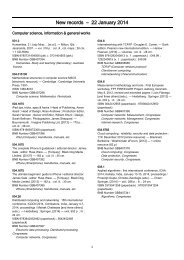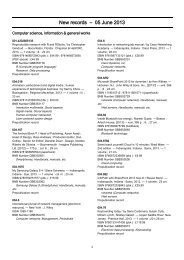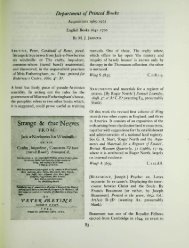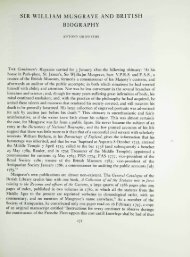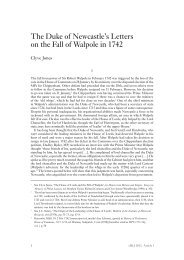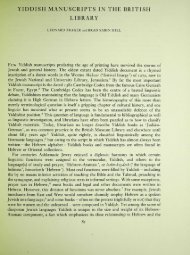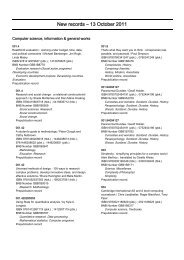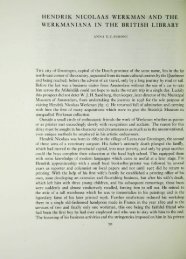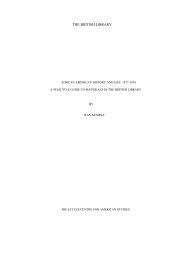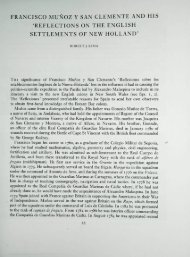A Medieval Psalter 'Perfected': Eighteenth-Century ... - British Library
A Medieval Psalter 'Perfected': Eighteenth-Century ... - British Library
A Medieval Psalter 'Perfected': Eighteenth-Century ... - British Library
You also want an ePaper? Increase the reach of your titles
YUMPU automatically turns print PDFs into web optimized ePapers that Google loves.
A <strong>Medieval</strong> <strong>Psalter</strong> ‘Perfected’: <strong>Eighteenth</strong>-<strong>Century</strong> Conservationism and an Early (Female) Restorer<br />
of Rare Books and Manuscripts<br />
This paper introduces Denyer and offers a preliminary assessment of her career. A<br />
substantial amount of information on Denyer has surfaced, although there is much yet to<br />
be discovered: my hope is that, in publishing a résumé of her activities, further information<br />
about Denyer might be brought forward by those who encounter details of her life and work<br />
not mentioned here. This essay is only a first attempt, but the findings published here suggest<br />
new avenues of inquiry into the modern origins of manuscript study. The historiography<br />
of this field has focused almost exclusively on the rapacity of its pioneers, whose looting<br />
we – as more enlightened still – have rectified and recompensed. Yet the career of Denyer<br />
troubles this metanarrative by presenting a different approach to the medieval object. Special<br />
attention to Denyer’s restoration methods reveals a logic that neither mirrors the irreverence<br />
of her contemporaries nor portends our own piety towards the artefact.<br />
The Denyer <strong>Psalter</strong><br />
The Denyer <strong>Psalter</strong> is in many ways typical for the late medieval period in which it was<br />
originally produced (see Appendix A for a description of the manuscript). A deluxe volume<br />
made in London probably between 1430 and 1440, the <strong>Psalter</strong> contains a common sequence<br />
of texts: it opens with a prologue by Jerome, which is followed by a calendar, all one hundred<br />
and fifty psalms, canticles, and then finally the Athanasian Creed. The manuscript almost<br />
certainly once contained a historiated initial for each of the major divisions of the Psalms,<br />
but only two of these initials remain in the manuscript. The first, preceding Psalm 26,<br />
shows King David, seated between two rocky outcroppings, before a red-and-gold-filigree<br />
background (fig. 1). He wears a large gold crown and a sumptuous blue robe lined with<br />
ermine. In the upper right corner of the initial, the face of God looks down from a blue<br />
swatch of sky, while David points to his left eye, alluding to the opening verse of the Psalm.<br />
In the second miniature original to the manuscript (fig. 2), David appears outdoors again,<br />
this time standing and pointing to his mouth, a reference to the text of Psalm 38. The hand<br />
of God extends from the sky, with two fingers in a gesture of benediction. These two scenes<br />
feature regularly in <strong>Psalter</strong>s made during the fifteenth century, and from their coherence with<br />
common iconography, we can infer that six other historiated initials once accompanied them,<br />
possibly depicting David with his harp, David with a fool, David drowning at sea, David<br />
playing bells, clerics before a lectern, and the Trinity. 3 Whatever their precise iconography,<br />
the six other initials are now gone, extracted from the manuscript at some point between the<br />
mid-fifteenth century and 1792.<br />
In 1792, a remarkable event in the life of the <strong>Psalter</strong> occurred. According to a note<br />
written on an added leaf (fig. 3),<br />
This MS was presented in July 1792 by Mr Joseph Parker of Exmouth to<br />
Miss Eliza Dennis Denyer of Chelsea (mutilated) who perfected the MS and<br />
illuminations with the Assistance of Mr William Jones who presented the<br />
frontispiece and several of the vignetts [sic]. 4<br />
What makes this event remarkable is the apparent intentionality with which this damaged<br />
book was brought to someone to repair. Little information on Joseph Parker (d. c. 1796)<br />
has yet come to light, although based on one published account, he appears to have been a<br />
3<br />
For a table of pictorial subjects in fifteenth-century English <strong>Psalter</strong>s, see Scott, Later Gothic Manuscripts,<br />
vol. ii, pp. 378-79.<br />
4<br />
Add. MS. 6894, f. 2.<br />
2<br />
eBLJ 2013, Article 3



